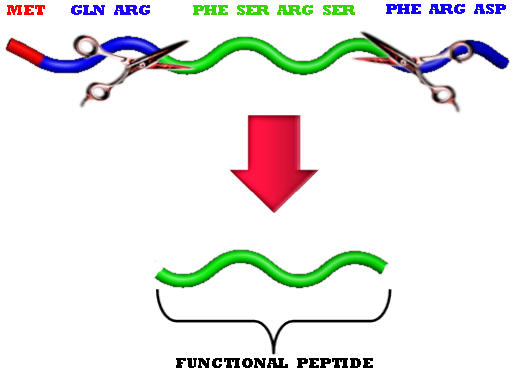Team:Imperial College London/M1/PeptideDelivery
From 2009.igem.org

Contents |
Peptide Delivery System
The Problem
Many short chain peptide drugs are suseptible to breakdown in the stomach making them suitable candidates for encapsulation.
When synthesised, all polypeptides begin with the same amino acid: methionine. This often removes the desired bioactivity of the compounds.
Some larger polypeptides are cleaved by proteases within the body into smaller functional peptides that do not begin with methionine (as shown on the image to the left.)
Making use of the peptide processing pathways within the body, we propose a universal template that can be used for the synthesis of all short chain peptides. By encoding a linker region that is designed to be recognised and cleaved by proteases within the gut, we get past the production difficulties associated with peptides, and allow for the release of these peptides into the gut. What is more, our system does not require the expression any additional genes!
Peptide Processing
To enable The E.ncapsulator to produce peptides without inhibiting their functionality, we have developed a removable linker region that starts with the amino acid methionine. Following the release of the peptide in the intestine, a naturally occuring enzyme (enteropeptidase) removes the linker region from the front of the peptide releasing the remainder in its functional form. The use of this linker region can be extended to any polypeptide that does not begin with methionine.
This image shows the universal template for peptide production. The methionine start is shown in RED, the protease recognition site is shown in BLUE and opiorphin is shown in GREEN. The RED & BLUE sections make up the removable linker region cleaved in the gut.
Module 1: Enzyme Production






 "
"





